|
Author
|
Topic: Mantlet, Pavise, Darts, and Box projects
|
Fire Stryker
Admin & Advocatus Diaboli
Member # 2
|
 posted 08-21-2009 07:55 AM
posted 08-21-2009 07:55 AM
    
I thought I would share a couple of pictures of a current project, amongst the equipment we are making for our artillery piece, the crapadeau 'Petite Gabriel'. We have been working on a pair of mantlet/screens, a wood planked one on wheels, and one made of wattling. The wood planked one is wheeled, so it can be pushed forward to cover the matross who reloads while he does so, this one is static,and will have a wood prop woven to the back of it.
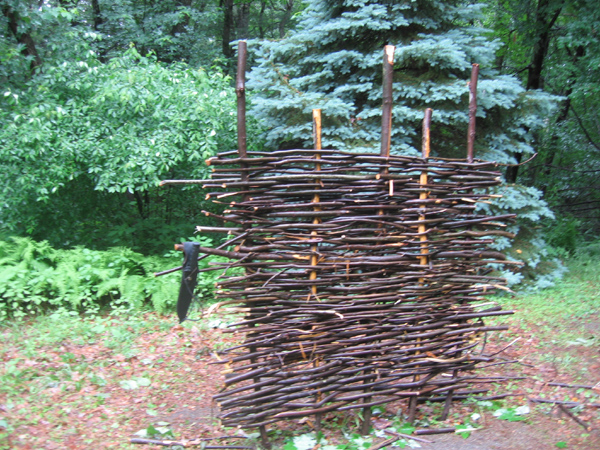
The mantlet is woven of green saplings, mostly beech, a little maple (we had to work with green saplings, and you will see why in the next image). 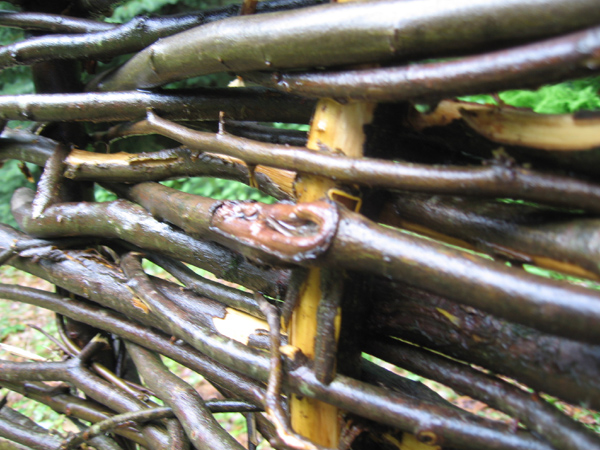 Here is a close up shot, of one of the supporting saplings. This was straight as a rod, and fully covered with bark as we began the project - there is so much tension in the weave, that the pole, which is 2" -2 1/2"- 3" thick (depending on which end you are at), has been bent and woven into the weave like the thumb-thick to 1 1/2" thick saplings, and the bark stripped with the weaving. The mantlet is as small as we could make it with the material - the idea was for it to be 3 1/2' across, and under 6' high - it is more like 4', by 6'. The mantlet was woven upside-down, with the poles dug into the ground. It has been since flipped, filled up with thinner branches, and neatly trimmed. The force of the woven saplings spread the poles at the bottom, even though we took every precaution to prevent this (we tied a rope to the bottom edge, and wove it as tight as we could to keep the poles as close together as we could).
We tested its effectiveness against archery, up to point blank-range, and prior to the weave being filled in. Out of 30 direct hits on the mantlet, one penetrated through the weave entirely (hitting a hole in the weave, since filled), about 1/3 of the shots bounced off, and the rest stuck in the weave, to no great depth (up to 3", maximum). What would happen is the arrow would start into the weave, and the friction would seem to have slowed it to a stop rapidly, without harming the fabric of the mantlet itself. A total of 1 arrow shot actually split the narrow end of one sapling, penetrating the other side to the depth of 1".
I will try to get some more finished shots this week - the weave goes right to the bottom now, and the top is filled. This was a very interesting project to undertake. Phil, the company member who headed it, has made wattle fencing before, and some wattle panels for a post-and-beam shed, and this was far more difficult to weave, due to the closeness of the poles, and the necessary minimum number of poles, all with the idea of being able to put it in the back of a pickup truck, or our Dodge Magnum, for transport. We have 8 hours work in the images, for 2 men, so a total of 16 man-hours at the point in the images, we have put a total of 2 more man-hours into it each since, so a total of 20 hours to the finish of the fabric. We could probably have wattled an edge or two of the garden, in the time this took, due to the looseness of weave of fencing, and the fact the height would have been half this.
Registered: May 2000 | IP: Logged
|
|
|
|
Fire Stryker
Admin & Advocatus Diaboli
Member # 2
|
 posted 08-21-2009 08:01 AM
posted 08-21-2009 08:01 AM
    
Mantlet made from wood planks. This artillery screen will have wheels and a trail. 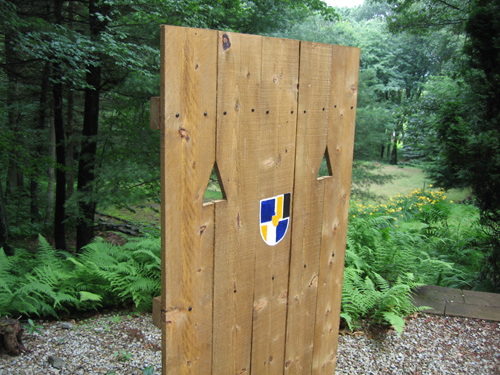 I should have taken some pictures of it as it went together, but I got shots while limning out the ducal arms. 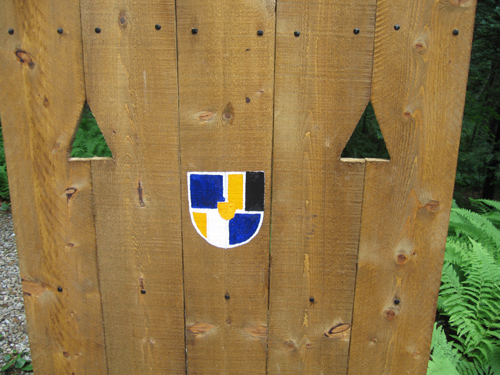 We based the cutouts on the somewhat larger screens (non-mobile) seen in Diebold Schilling, the images of the Burgundian army besieging Morat. 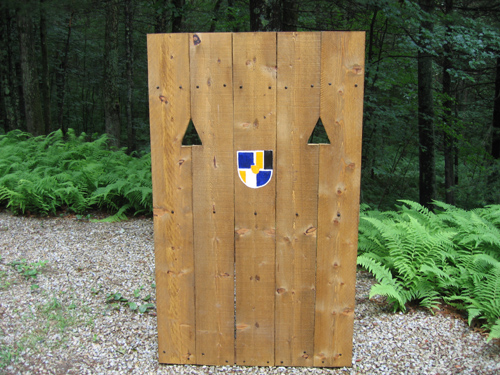 Here is a full length of the screen, it will sit 5" higher with the wheels in place, and the trail will cock it back maybe 10 degrees. Lastly, a close up of all the fields and borders limned out - what a pain in the butt, waiting for the linseed oil based paint to dry. 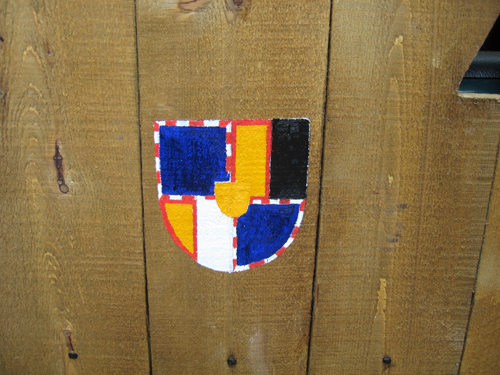 The person doing the original fields put some blue over the border of France Ancient in the first quarter, and now we must wait a long bit for it to dry, to put the white check over it. He was flogged until he fainted for his error. 
Registered: May 2000 | IP: Logged
|
|
Fire Stryker
Admin & Advocatus Diaboli
Member # 2
|
 posted 08-21-2009 08:04 AM
posted 08-21-2009 08:04 AM
    
Fleche de Maine: Hand ArrowsWhile waiting for the rain to occasionally break, to do outside projects. I have been putting together 4 small javelins - literally 'hand arrows', in the artillery accounts, quite a few of which show up in inventories of the artillery held in a castle. 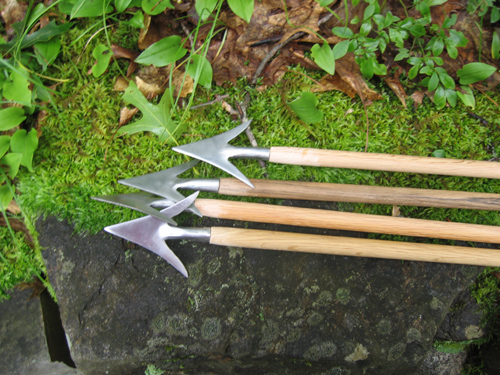 The darts are almost invariably broad-heads, and going by the images I have to work with, they seem to range between 4'-5' long, although some more spear-like ones show up,. over the 5' mark - with narrow spearheads instead of broad-heads, usually. 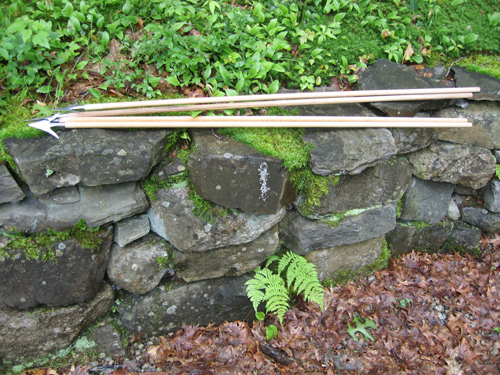 The photos are taken immediately after I had headed the darts, and shouldered down the shafts - you can see the marks of the files if you look at the photo of the heads. They are sanded and waiting fletching now, I will put up more pictures after the fletching process. Images of these darts are found in a couple of British Library held manuscripts (a Froissart, for one, I think), as well as the Hours of Mary of Burgundy (The pursuit by death), and a nice manuscript held in the Hauge , of the story of Jason and the Argonauts - all ranging between 1470-1480.
Registered: May 2000 | IP: Logged
|
|
Fire Stryker
Admin & Advocatus Diaboli
Member # 2
|
 posted 08-21-2009 08:05 AM
posted 08-21-2009 08:05 AM
    
These things were fletched as if massive arrows (I'm putting 9" of fletching on them), so I am not sure regarding how effective they would be thrown with the fletching. The images show them all being thrown overhand, like javelins.Interestingly enough, I was going through Gaier last night, and in 1443, the comptroller of the ducal artillery recorded some 21,050 heads for 'flesche de main' in one castles stores. Also, they had a variety, I counted in the list of the type of dart/javelin weapons the following catagories 'flesch de main', 'dard', 'dard de fer', 'dards de Espagnie', and 'javelins'. Apparently, there was a variety of the weapons in use. These were entirely separate from arrows, arrowheads, quarrels, and artillery ammunition (as late as 1461, we have record of Burgundian artillerists employing arrow-like projectiles in cannons - like a sabot round, all metal, apparently, and with two sets of fins per projectile, one set of three to the rear, one set of three to the middle.) Here I am trying to post an image from that 1470 Jason manuscript, hopefully, it is small enough to attach. (attachment too big, of course, I will try re-sizing later.) Bob
Registered: May 2000 | IP: Logged
|
|
Fire Stryker
Admin & Advocatus Diaboli
Member # 2
|
 posted 08-21-2009 08:07 AM
posted 08-21-2009 08:07 AM
    
I went and trimmed the two sets fletched, and I have to re-do the job. I have never fletched before, and the jig is mismarked. I am in process of fixing the two now, but I did trim them ill-fletched, and experimented throwing before the fix.The fletching improved accuracy in the horizontal toss, and the throw from a height - it made no improvement to range, but a novice can hit what they are throwing at, by in large - I almost killed a chipmunk on the fly with one, thrown down from the back porch. 9 times out of ten, throwing down from a height of 20', you hit what you aim at, out to, say a maximum of 15 yards from the base of the height you are throwing at. The force of impact has been increased by adding the fletching, and a vertical throw downward burys the head completely, and a few inches of the shaft. A horizontal throw, you hit roughly what you are aiming at, 7 or 8 times out of 10, and it strikes the ground with enough force to bury the head itself. The dart "toss", with the size of the fletchings (based directly off the Jason manuscript), makes the dart toss impossible, with a dart of this length. It was do-able to a degree without the fletching, with the fletching, it just does not work properly. You can do it with an arrow, which is a foot less in length, and with a properly tapered shaft. I am sure that they would be effective, thrown at a game animal from a moving horse. I am certain they could wound or kill an unarmoured man, with a throw from a height, but the more armoured the target, the less useful they would be. I would think you would instinctively flinch from one thrown at you with intent, even fully armoured. You could kill or wound a foot-soldier, no doubt, with a well-aimed or lucky throw. Bob
Registered: May 2000 | IP: Logged
|
|
|
|
Fire Stryker
Admin & Advocatus Diaboli
Member # 2
|
 posted 08-21-2009 08:12 AM
posted 08-21-2009 08:12 AM
    
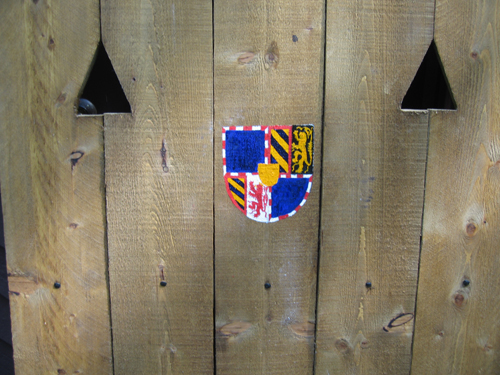 The arms are further limned out, Burgundy is complete, the various lions of Flanders and Luxembourg are roughed in, awaiting detailing. 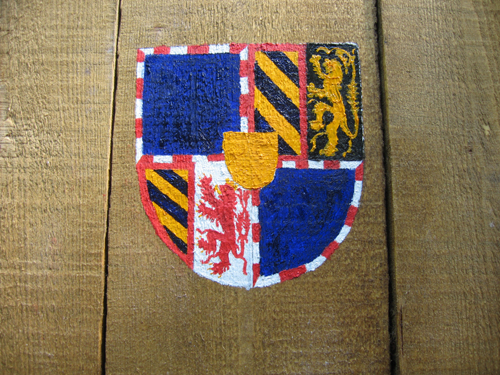 A close up shot, the lions still need detailing, but the next step is painting in the powdered fleur de lys, and the last lion, after that dries, then going in to pick out the last details. 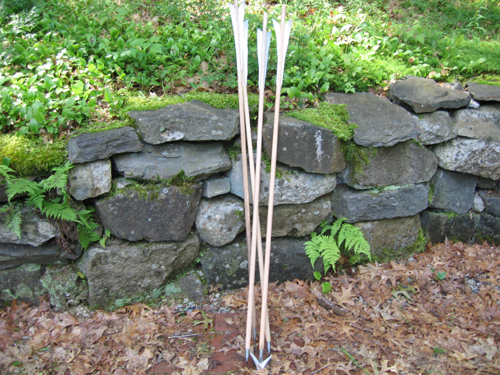 I've glued and cut the fletching, but it still needs to be bound, and I need to oil the shafts to finish them, and probably, I will wax the binding of the fletching, to add one more level of security 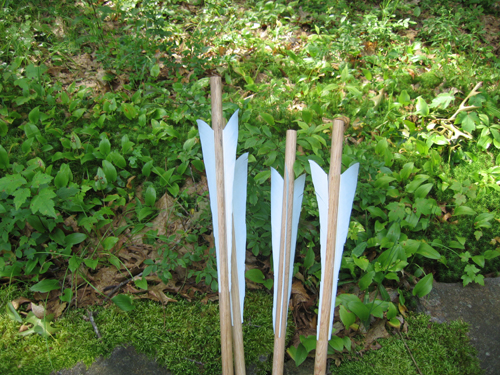 A close-up shot, don't laugh, I have never fletched anything before in my life. I was lucky to align the feathers properly, the jigs markings are less than helpful. I am pretty certain I could increase performance, if I replaced the crappy Hanewaii broad-heads, with real ones. I might contact Hector Cole, or someone like that, to make me up another six heads, but decent. Bob
Registered: May 2000 | IP: Logged
|
|
Fire Stryker
Admin & Advocatus Diaboli
Member # 2
|
 posted 08-21-2009 08:13 AM
posted 08-21-2009 08:13 AM
    
Once the fletching is properly finished (and we get some proper broad heads), we'll be putting them through some tests.Jenn -------------------- ad finem fidelis
Registered: May 2000 | IP: Logged
|
|
Fire Stryker
Admin & Advocatus Diaboli
Member # 2
|
 posted 08-21-2009 08:16 AM
posted 08-21-2009 08:16 AM
    
More images.We have finally gotten around to weaving in the cross member of the wooden prop for the wattle mantlet. 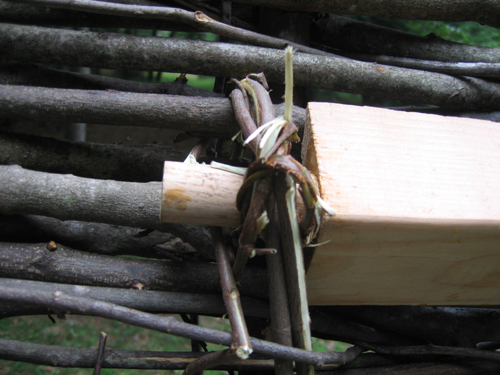 We had been stumped as to how to go about this, but Mac provided the suggestion of getting some thin green sapling branches, and then braiding/plaiting them for strength and flexibility, to enable them to be woven into a bracket. The idea worked very well, but in weaving the support in place, the actual braiding came loose, as you can see. 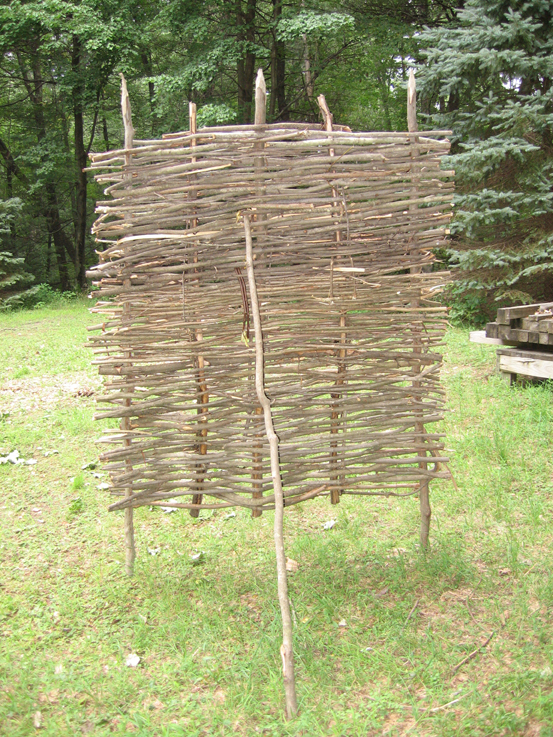 Here it is, propped up from the front-side, now that we have established the height, I can cut the permanent wood prop, and affix it to the crossed support we just wove in. Over the last couple of weeks, the green wood has shrunk some, so we will weave in some more filler, to stop up the gaps you can see now. We still need to trim the bottom two legs, and 'sharpen' them. 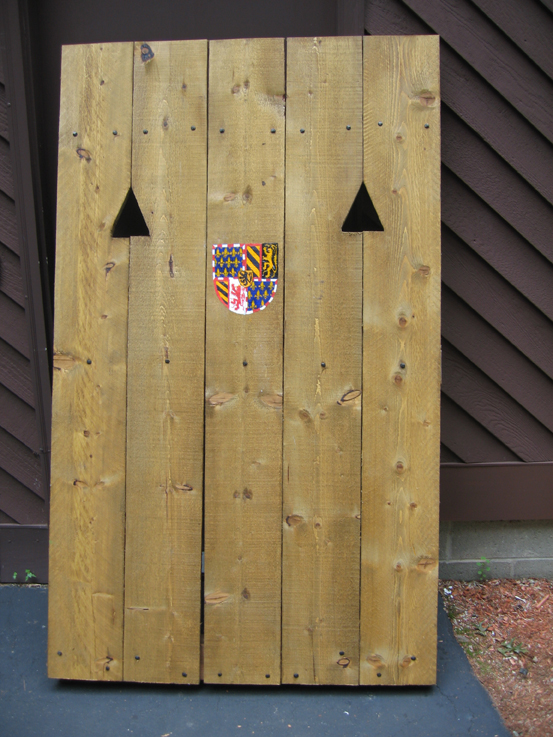 The Burgundian arms on the plank mantlet has progressed as well, we have touched up the lion of Flanders. We had to go back in on the central lion of Hainault/Holland, and widen the yellow, as when we did the initial outline of the escutcheon in black, the paint ran, Next week, I trim up the escutcheon once again, and it will lose the 'lop-sided' look. 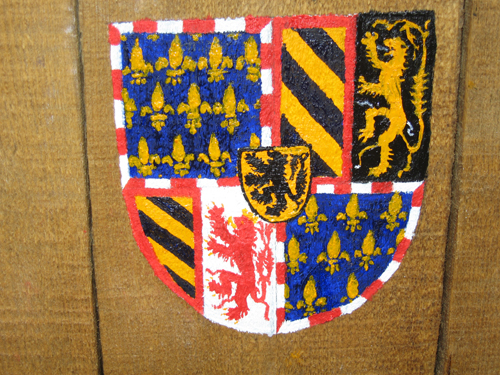 Next week, the lion of Flanders gets the last of it's fur, and is armed and launged, the center escutcheon is touched up, the lion of Luxembourg gets its detailing, and the Fleur de lys gets sharpened and adjusted. We have probably 2 more weeks work, before we varnish the coat of arms. We had the ironwork for the pin for the support made last weekend, so this is getting close to being done as a entire mantlet. I still have to bind the javelin fletching, but I don't need it for a presentation until the Saturday next, so it is temporarily on the back-burner. Bob
Registered: May 2000 | IP: Logged
|
|
Fire Stryker
Admin & Advocatus Diaboli
Member # 2
|
 posted 08-21-2009 08:20 AM
posted 08-21-2009 08:20 AM
    
Here are some images of the wattle mantlet finished. Here it is playing down collapsed, you can see we shortened the legs, and sharpened them up, and the prop in its socket in the cross-timber prop. 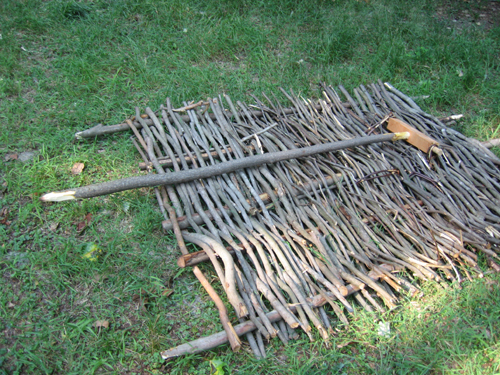 Completed front 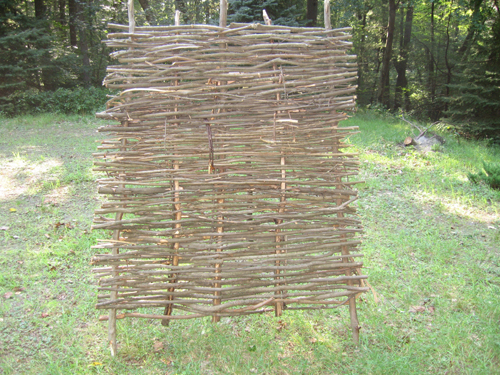 Showing a close up of the prop, and how it is set into the mantlet. 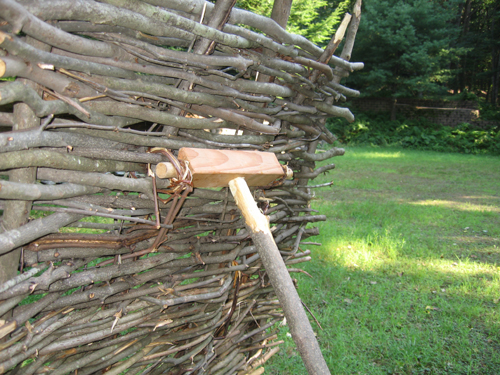 Full on from the rear. The thing is incredibly strong, having beaten on it with a heavy billhook, cutting, trimming,. and trying to keep it pounded together, I think you would literally have to take it apart with an axe, and take out a section at a time to break it up. 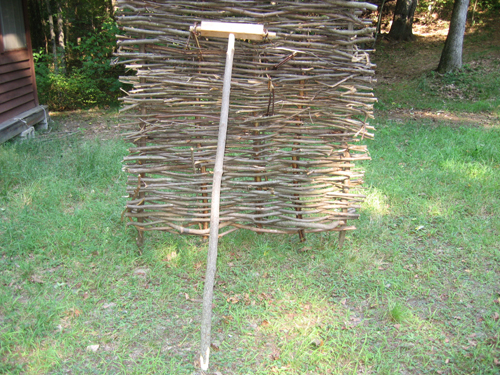
Registered: May 2000 | IP: Logged
|
|
Fire Stryker
Admin & Advocatus Diaboli
Member # 2
|
 posted 08-21-2009 08:23 AM
posted 08-21-2009 08:23 AM
    
PAVISEHere is a pavise we are working on (one of a set of 3), copied in shape and size from the two surviving small pavises of die Burgunderbeute (yes, it is flat-ish, as was the original) 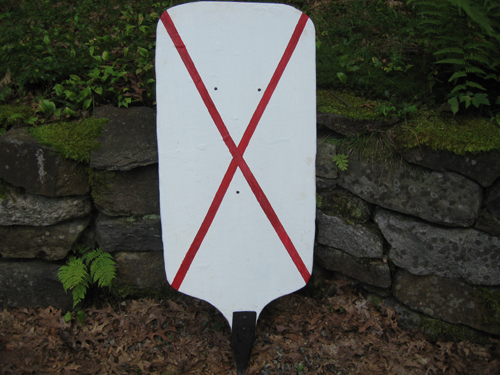 Clay Gilbert of Fungi Forge made the pavise spike, and the handle. 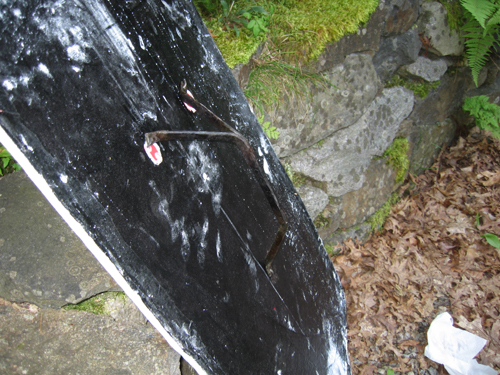 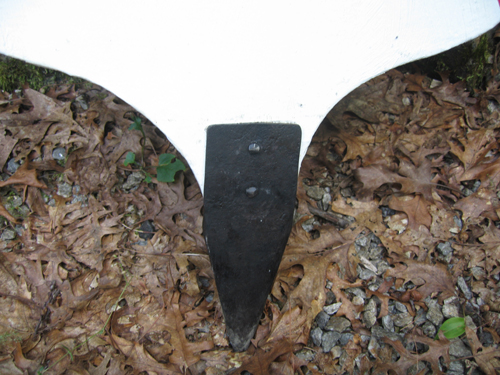 The painting is hardly underway, we have only painted the field, and to indicate the St. Andrews cross., which will be slightly widened. There will be 4 fire strikers in gold, 4 black flints, and the entire field powdered with red flames, on the two white pavises. We also have one underway with the same design, but with a split field in Burgundian livery (parti-per pale, argent and azure). These are 'beater' pavise, in that they have a plywood core, and are covered with fabric and gessoed, instead of being covered with deerskin, like the original. We have one that has been underway for a while, that will be covered in deerskin, like the original, made of poplar boards, like the original. The three beater pavise for the field are the test run for the reconstruction. I don't mind using these ones, but I would cry if we wrecked the reconstruction. There are three extant pavises like this, two from 1476, one of which is blue and white, the other being white overall. One exists from 1480, to the exact same pattern, made for Maximilian I, during his wars of Burgundian succession.
Registered: May 2000 | IP: Logged
|
|
|
|
|
|
|
|
Randall Moffett
Member
Member # 11233
|
 posted 08-06-2010 07:25 AM
posted 08-06-2010 07:25 AM
   
Very cool projects. The hand darts are very interesting. Where did you get the heads for them? They show up quite often in the 13th-15th in Southampton, especially on ships. Another great little finishing tough though.I'd love to make a pavaise someday but have so many other projects who knows how long that will take. How have you constructed this one? Nice work! RPM
Registered: Aug 2010 | IP: Logged
|
|
Fire Stryker
Admin & Advocatus Diaboli
Member # 2
|
 posted 08-09-2010 06:02 AM
posted 08-09-2010 06:02 AM
    
Simply planks of linden/Poplar, glued and clamped. The shape cut out of the boards.
The boards were sanded The pavise is wrapped in canvas that has been gessoed and sanded. Then painted overall. Then the iron work was applied.
Registered: May 2000 | IP: Logged
|
|
|
|
|
|
|





 UBBFriend: Email this page to someone!
UBBFriend: Email this page to someone!





 UBBFriend: Email this page to someone!
UBBFriend: Email this page to someone!